SALMON POKE-D YOU. YOU SHOULD POKE BACK
Two weeks ago when I stood in front of the ordering-counter in the most celebrated poke (a Hawaiian appetizer mostly made with raw seafood and other seasonings) joint in Honolulu, I found myself deep, once again, in a familiar dilemma. I could on one hand, dig through the baffling complicatedness for the source of the tuna without certainty on any given answers which would probably result in an ill-informed purchase anyways, or, I could entirely forgo the option of tuna as a food source just as I’ve been doing for quite awhile now. After all, I hadn’t tasted a bite of tuna, raw, cooked or canned for let’s say… almost 3 years.
The incentive is simple – beyond animal welfare or even the fear for environmental impact – that goes… I like tuna. And would like more to eat in the future if possible. Should I say chewing my way through a specie to the brink of extinction isn’t how I would like to be remembered going down.
We should, or at least I hope, be genetically and socially more advanced than locusts.
An idea so seemingly intuitive that it’s mind-boggling it isn’t shared by most. That being said, my internal tuna-war isn’t as straight-forward as it sounds. Unlike an hypothetically obvious STOP sign on say, a whole roasted panda or I don’t know… wild tiger tenderloin, the choice being made on what should be considered “responsible” tuna comes with brain-batting confusion. There are the different species of tuna, regions where they are caught and most importantly HOW they’re caught, all of which boils down to to a few beyond-basic guides that are too confusing to be reinforced by most. So for the sake of simplicity and sanity, in a world that now transport tunas across the furthest regions from one another without an unified consensus and regulations on how they come about, I just decided to veto tuna entirely.
But that day, I caved. Without any other choices of fish they offered, we acted upon an unspoken unison of guilt and shared an order of ahi/yellowfin tuna shoyu poke, by then without the ease of knowing that Hawaiian ahi/yellowfin tunas (a relatively less threatened specie) are mostly caught in a regulated sustainable method, a peace-of-mind that came long after this trip from an online research. It was a fortunate coincidence and not of conscious choice, and now that we’re back, a dumb luck that I would definitely not run into in the biggest country in the world that doesn’t give a Chinese shit about food sustainability. To recreate the poke-experience, an extremely delicious one at that, I used a different choice of fish.
Should you do the same? The answer, along with the process that will get you there, isn’t easy, transparent, or even without contradiction. But at the end of the longline, with a shot at the juvenile hope for any change in this world, you should first give a damn.
Serving: 3 ~ 4
Traditionally, Hawaii-style poke is made of ahi/yellowfin tuna (not salmon), limu (a type of fresh seaweed) and ground kukui (candlenuts). I couldn’t. Get any of those things. But it turns out, I don’t miss the seaweed all that much and cashew (or macadamia nuts) is an excellent substitute of kukui nuts. Salmon (although has its fair share of controversy, but a relatively benign alternative), of course tastes entirely different from ahi tuna but I don’t know if you have heard, the tuna-community worldwide direly needs a breather from our suffocating love/appetite. Unless you are certain of the ahi tuna coming from a sustainable source (troll or pole-caught), don’t buy it. Eat responsibly.
Ingredients: inspired by Honolulu’s Ono Seafood
- Chili and garlic water:
- 4 small red chili
- 1/2 tsp of chili flakes
- 1 clove of garlic, smashed
- 1 1/2 tsp of salt
- 2 tsp of rice vinegar
- 1/2 cup of water
- 21.2 oz (600 grams) of sashimi-grade salmon (preferably Alaska wild salmon)
- 2 tbsp of soy sauce
- 1 1/2 tbsp of chili and garlic water
- 1 tbsp of sriracha sauce
- 1 tsp of sesame oil
- 1/2 cup of thinly sliced onion
- 1/2 tbsp of toasted sesame seeds, plus more for sprinkling
- 8 roasted cashews
- 2 tsp of chili flakes
- 1 1/2 tbsp of soy sauce (darker soy sauce preferred), plus more for adjusting
- 1 1/2 tsp of sesame oil
- 1 tbsp of chili water
- 2 tbsp of of finely diced scallion (green parts only)
- 2 avocado, optional
- Steamed sushi rice to serve
To make the chili and garlic water: Finely mince the red chili and add it into a jar with chili flakes, smashed garlic, salt and rice vinegar. Mix evenly and let sit for 10 min. Bring 1/2 cup of water to boil, then pour it into the jar. Let the mixture sit at room-temperature for 2 ~ 3 hours before using.
To make the salmon poke: Cube the salmon into bit-size chunks and place in a large bowl. Add soy sauce, chili and garlic water, sirracha sauce and sesame oil. Mix evenly then cover with plastic wrap. Chill in the fridge to marinate for 30 min.
Finely slice the onions and cut into short segments. Soak in cold water for 5 min to reduce the sharpness of raw onions, then drain the water off completely. Pound and grind toasted sesame seeds and roasted cashews in a stone-mortar into a coarse powder-consistency. Take the marinated salmon out of the fridge and add the onions, ground sesame/cashew, chili flakes, soy sauce (Depending on the saltiness of the brand, you may need to add more/less to adjust to taste. Poke is supposed to be on the saltier side to go with rice.), sesame oil and chili/garlic water. Mix evenly and chill in the fridge for another hour.
Right before serving, mix in the diced scallion and sprinkle with toasted sesame seeds. Serve the salmon poke over warm steamed rice and diced avocado. Drizzle with more chili/garlic water for more kicks.


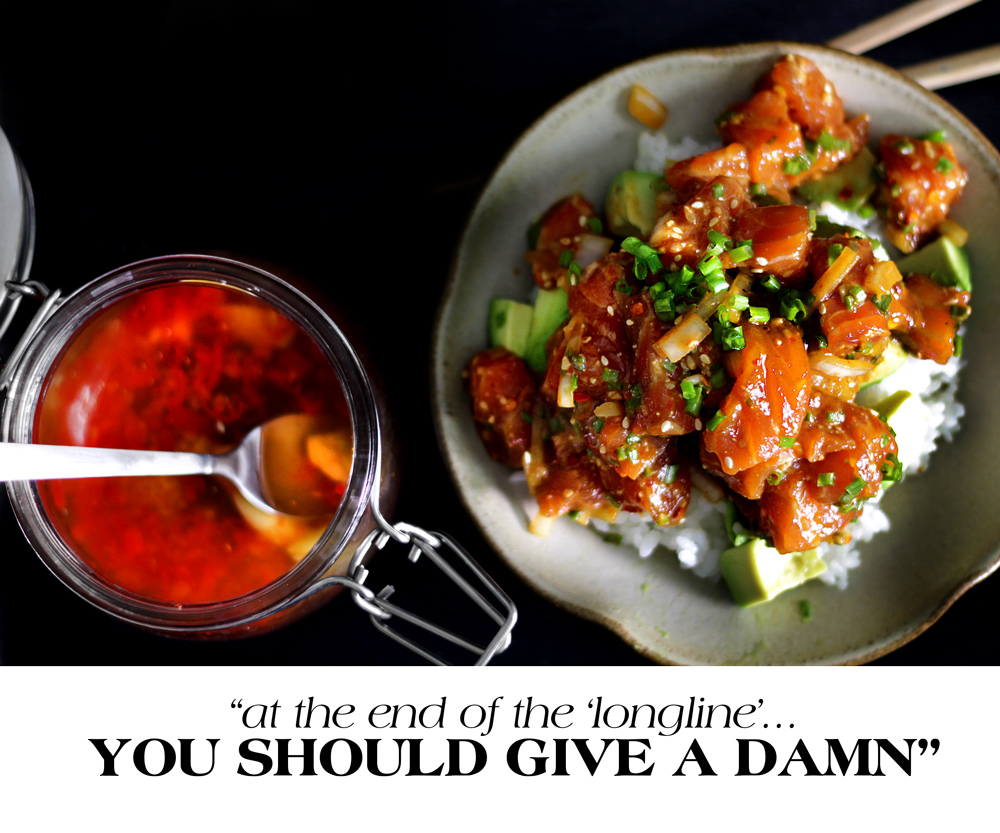
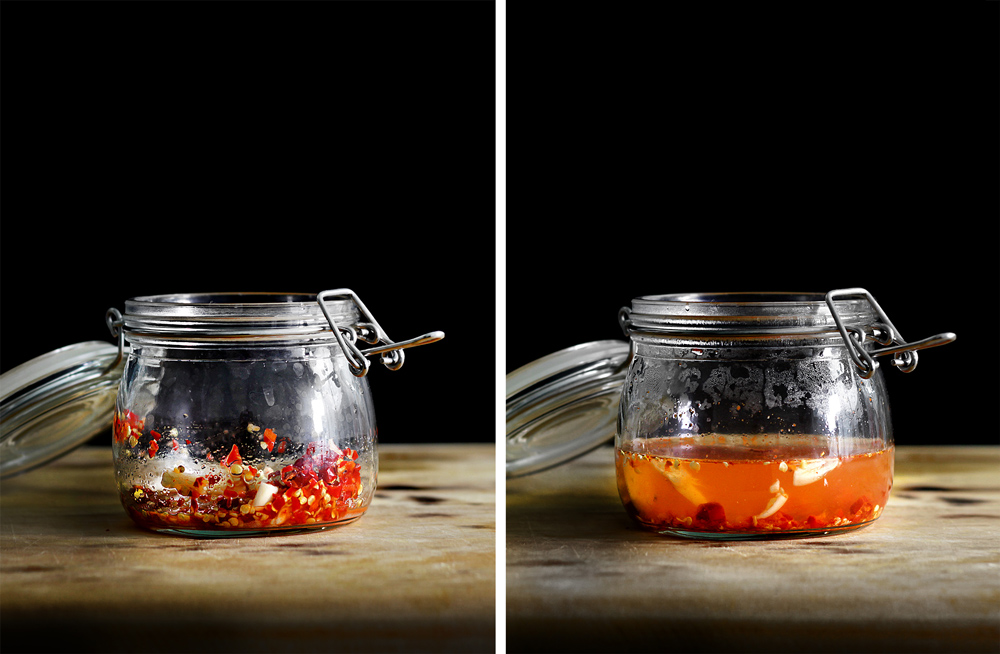
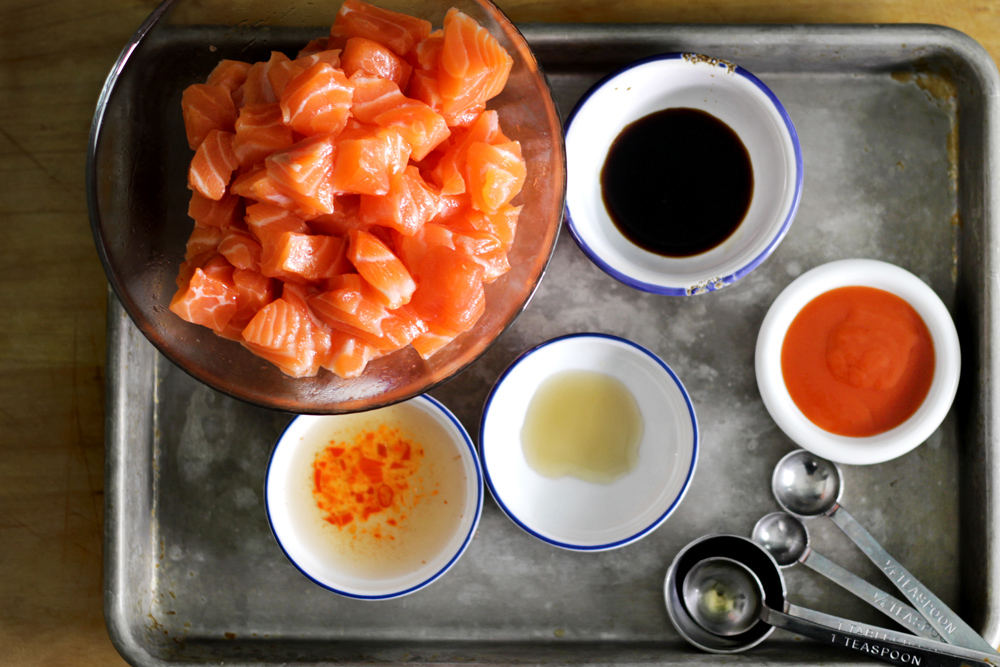
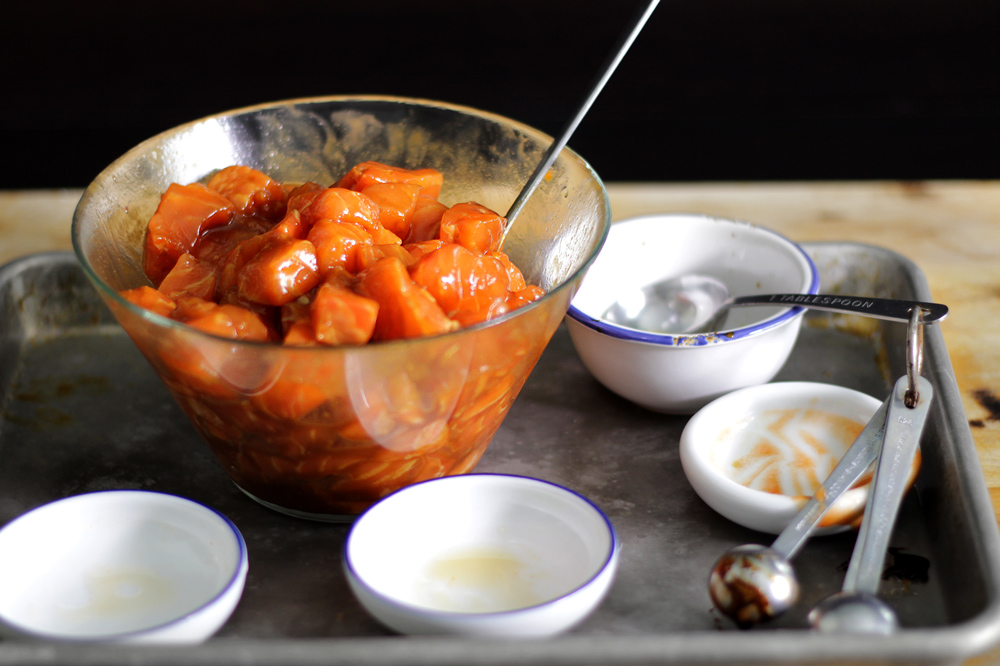
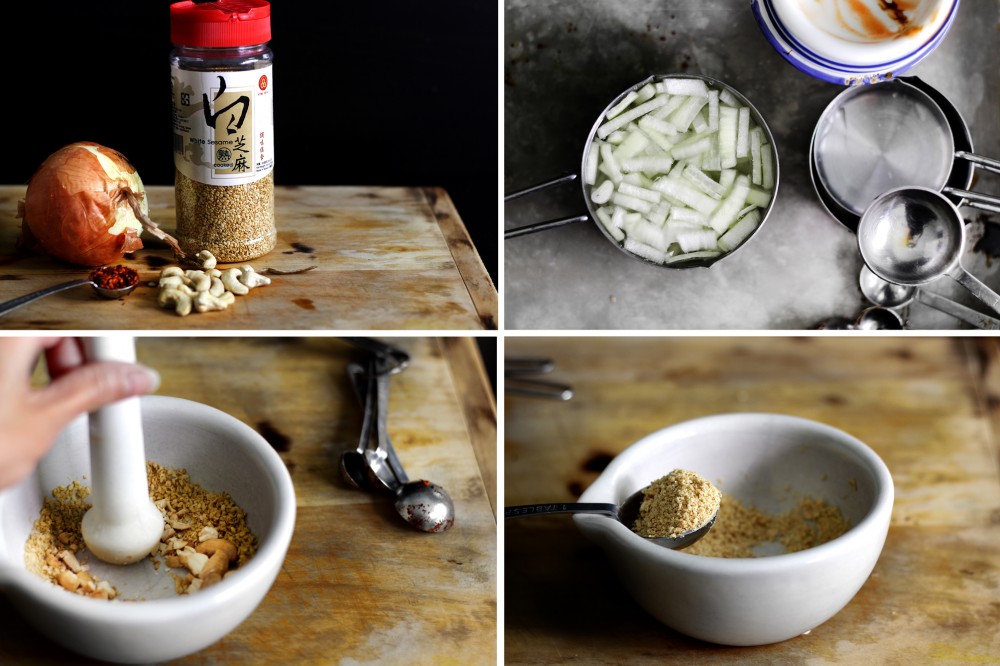
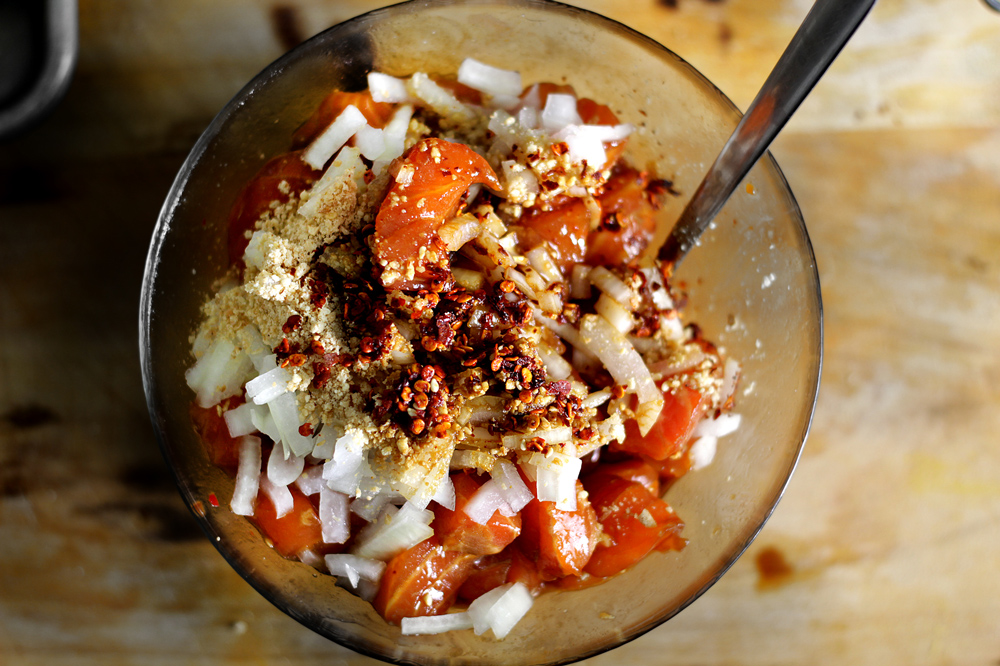
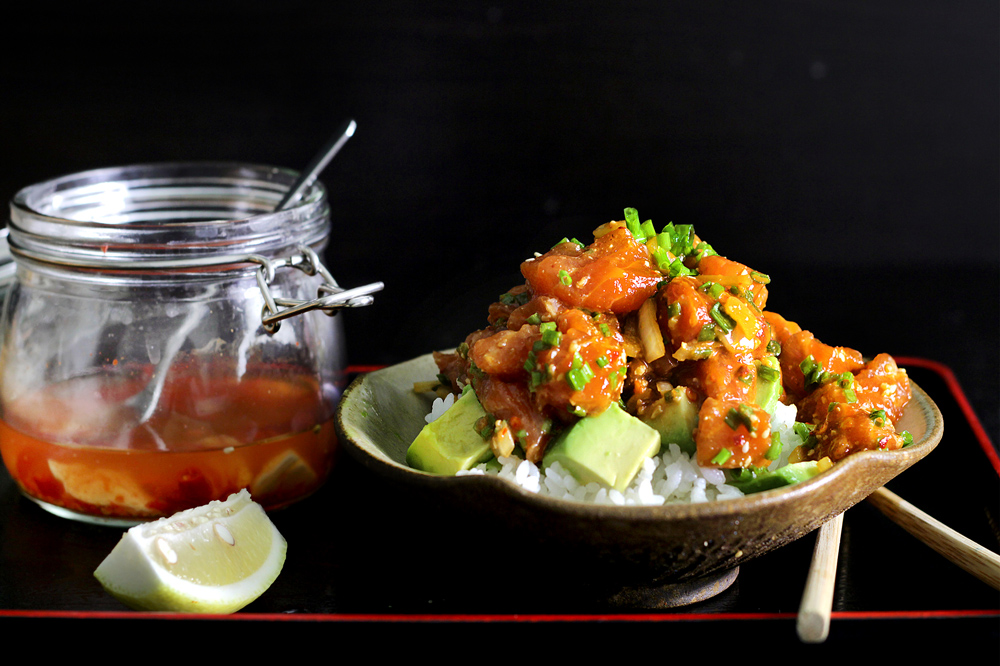
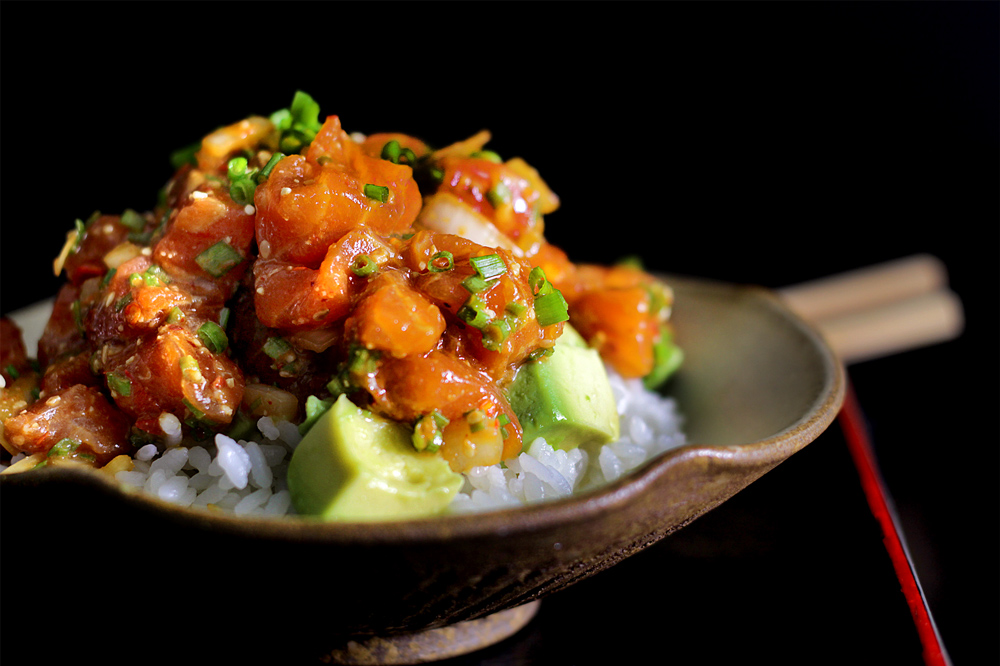
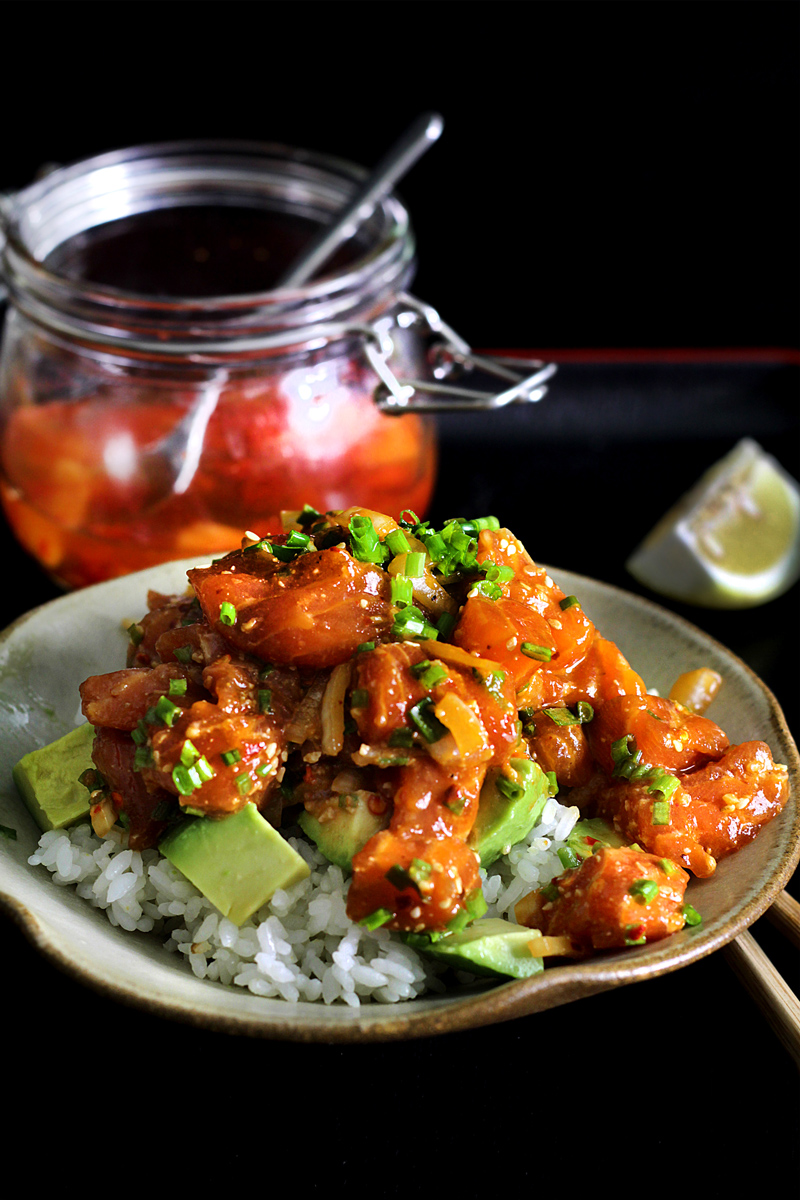
Belinda @themoonblushbaker
10.15.2013at8:11 PMThe peril of the watery commons are well known in Australia, we have completely re written the fish guild lines now; That blue fin can only be sourced from one area at a pre determined time. The sources of tuna, whether can or fresh; sustainability is always the buzz word. Surprisingly the taste for blue fin actually is become more common in western countries than Japan, go figure.
Love the topic of this post. Too often we forget the dynamics of bug business has on the availability of traditional foods.
Todd @ HonestlyYUM
10.16.2013at1:17 AMI think I prefer the salmon anyhow. This looks absolutely mouth-watering!
Mandy L.
10.16.2013at2:01 AMTodd, thanks so much for sharing it on your beautiful blog :)
Roberta @ fish chips & gelato
10.16.2013at2:24 PMThat looks tasty, Mandy! I always feel guilty about eating fish. Here in the UK the level of interest in fish sustainability among the public is VERY low to say the least. I seem to have a thousand apps or PDFs telling me which fish I should go for and when and which ones I should avoid, and they all seem to contradict each other…
Anyway, I am in love with your blog. One of my favourites to peruse lately!
Mandy L.
10.16.2013at3:24 PMRoberta, yes the “guides” are beyond confusing! I stay with a general rule of eating smaller fishes like sardines, which I love anyways.
Meli
10.16.2013at3:46 PMI love raw salmon (and cooked salmon in any way of preparation, I admit) and this seems to be my next salmon try…;) Thank you for your blog, Mandy, I found it about two months ago and this is one of the most inspiring web places for me. Wish you luck, you are really very, very good!
Kirsten
10.16.2013at4:47 PMHi! I was watching a programme about tuna fishing in the South Pacific at the weekend. It is no wonder that the species is becoming extinct when they scoop up whole schoals of tuna in one massive net, 150 tonnes at a time. I try my best to buy responsibly sourced tuna when that’s what I fancy, although I have to say that my consumption of tuna has dramatically reduced over the years.
This recipe looks delicious. What can I use instead of sirracha sauce? I’ve never come across this before in the UK, even in oriental supermarkets.
Mandy L.
10.16.2013at7:01 PMKristen, oh boy… I’m not sure if there’s adequate substitute for Sriracha The Great, except for maybe some generic brands out there that mimics the taste, and that unfortunately varies depending on where you are at. For UK, I’d say go online to purchase is the easiest way. Amazon UK carries it: http://www.amazon.co.uk/s/ref=nb_sb_noss?url=search-alias%3Daps&field-keywords=sriracha
Kirsten
10.16.2013at8:25 PMThanks – this is really helpful! Feel slightly ashamed for not consulting ‘Amazon the Oracle’ myself first.
nikkipolani
11.03.2013at2:07 AMI love raw salmon and this recipe has become a new favorite — so rich and delicious. Thanks for the detailed step-by-step. I can’t stop eating it even I’d eaten my fill!
Garee Stewart
12.09.2013at12:57 AMI found yore blog this morning and the meatballs are on for tonight. They look awesome. Do you know if there is a web site to order produce like galengal and curry lime leaves?
Mandy L.
12.09.2013at8:11 PMGaree Stewart, are you in the US? I order fresh lemongrass and lime leaves in BJ from the internet sometimes but have never done it in the US. I googled “buy fresh lime leaves online” and found this place: http://importfood.com/freshthaiproduce.html. But since I have never purchased from them before, I can’t say for the quality or service. My advice is try looking for them at Asian supermarkets first, and if unavailable, try the website. Buy more than you’ll need and freeze them (they freeze really well). That way you can save on some shipping. Good luck!
Aubrey
02.09.2014at6:28 AMHi,
This recipe looks amazing. How/where do I get sushi-grade salmon? Thanks!
Mandy L.
02.09.2014at2:34 PMAubrey, my best bet is to go to a Japanese supermarket. I don’t know if you have a seafood market to go where you can find a credible fish monger?
一凌
04.08.2014at4:28 PM看起来好好吃(*^__^*) 嘻嘻……
Erin
03.13.2015at6:11 PMOMG…my boyfriend’s family owns Ono Seafood!! I’ve been slowly working my way through your archives (oldest to newest…I’m on page 13) and just read this post in it’s entirety. I hope you tried the spicy ahi, the hot sauce his grandma imports is RIDICULOUS!!
mandy@ladyandpups
03.14.2015at1:42 AMErin, we did try the spicy ahi! And it was superb!! The “chili water” made it even better.
betty
10.13.2015at11:37 AMI loved this story and I’m definitely going to try this recipe. I love all your recipes, you are my most pinned blog. I have been slow,h working my way through. just made ragu today but I digress. so glad you made it to our lovely island. were you here for the food festival?
mandy@ladyandpups
10.13.2015at1:02 PMBetty, I wish I was in Hawaii for the food festival!! I’ve been trying to find an excuse to go back.. It was such a treat to be there.
Vanja van der Leeden
01.26.2016at11:19 PMI hate you. You remind me of a class mate in school – she excelled in everything. Giving you compliments seems almost lame. “Your photography is really good, your writing is edgy and your recipes are close to genius”. And then you do those little drawings too sometimes. I am not even going to try to tell you how good you are. But if you ever visit The Netherlands (I wouldn’t know what for, we don’t have a food culture), we should meet.
mandy@ladyandpups
01.26.2016at11:58 PMIndeed we will, Vanja, indeed we will :P
Romeo A
07.25.2018at12:34 AMCan you make a restaurant already?!?!?
Anna
08.23.2018at12:04 AMMuch as I love fantasising about eating your more elaborate creations, I hardly ever get round to following the many-stepped recipes. This, however . . . I made it last night and it tasted as good as any restaurant – and so easy! Thanks Mandy